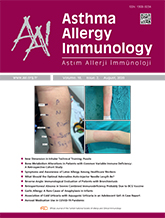


Objective: To evaluate the knowledge levels, sensitivity status, familial latex sensitivity, and attitudes towards the prevention and treatment of latex allergies of healthcare workers (HCWs) at a tertiary hospital.
Materials and Methods: The study was carried out cross-sectionally between December 2012 and March 2013. A total of 566 HCWs at a tertiary hospital were included in the study.
Results: The data of a total of 566 [333 (58.8%) female and 233 (41.2%) male] HCWs were analyzed. They consisted of 179 (31.6%) physicians, 48 (8.5%) technicians, 238 (42%) nurses, 48 (8.5%) laboratory technicians and 53 (9.4%) patient care workers. The family history of atopy was significantly higher in female HCWs (24.3%) compared to males (17.2%) (p= 0.041). A significant difference was identified between the occupational groups in terms of the rate of allergic symptoms after coming into contact with medical latex products (nurses 59.7%, doctors 17.6%, technicians 5.7%, laboratory technicians 6.9 %, patient care workers 10.1%; p= 0.001). Latexrelated symptoms were significantly more common in atopic HCWs (52.3%) compared to non-atopic ones (19.4%) (p= 0.001). The rate of latex-food syndrome was significantly more frequent in female HCWs (16%) compared to males (8.9%) (p= 0.038). Symptoms that developed after contact with medical and non-medical latex products were significantly more common in female HCWs (79.9% and 80.5%) compared to the male HCWs (21.1% and 19.5%) (p= 0.001). The rate of non-HCW(s) who shared the same house/room with the HCWs after work and who had allergic symptoms while in the same environment with the HCWs was 18%. The rate of these individuals was reported to be highest among the nurses at 53% and there was a statistically significant difference in terms of occupational groups (physicians 25.5%, technicians 9.8%, laboratory technicians 2.9%, patient care workers 7.8%; p= 0.030). Multivariate regression analysis showed that personal history of atopy (OR= 28.657, 95% CI= 6.548-125.411, p= 0.001) and the type of gloves used (latex gloves) (OR= 8.730, 95% CI= 3.490-21.834, p= 0.001) were independent predictors for latex allergy.
Conclusion: In conclusion, latex is not only a cause of occupational allergy but is also an allergen that has the potential to cause allergic symptoms in people who share the same environment with HCWs. Questionnaires questioning the symptoms associated with past latex allergy may be an important tool for demonstrating latex sensitization in HCWs and managing latex-related reactions.